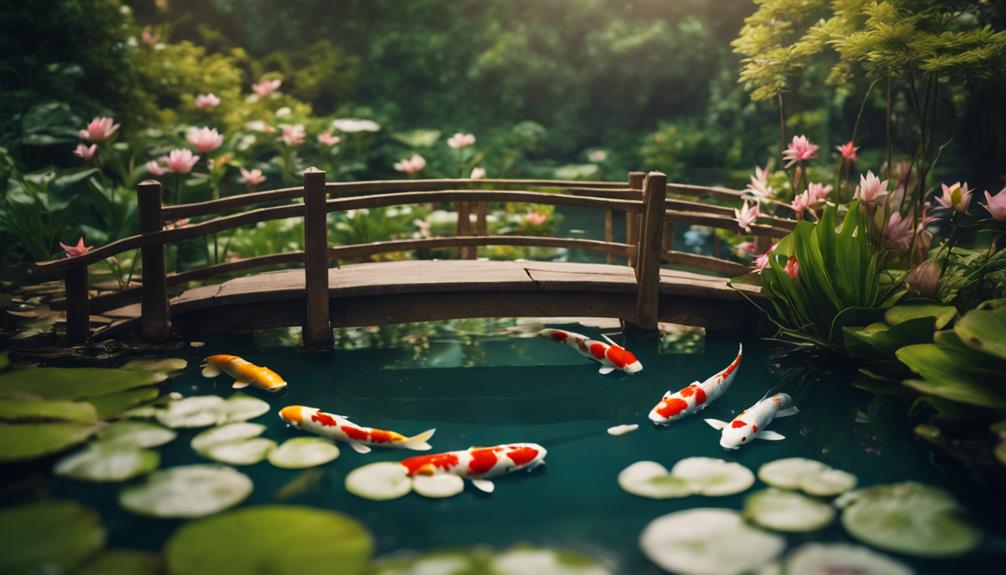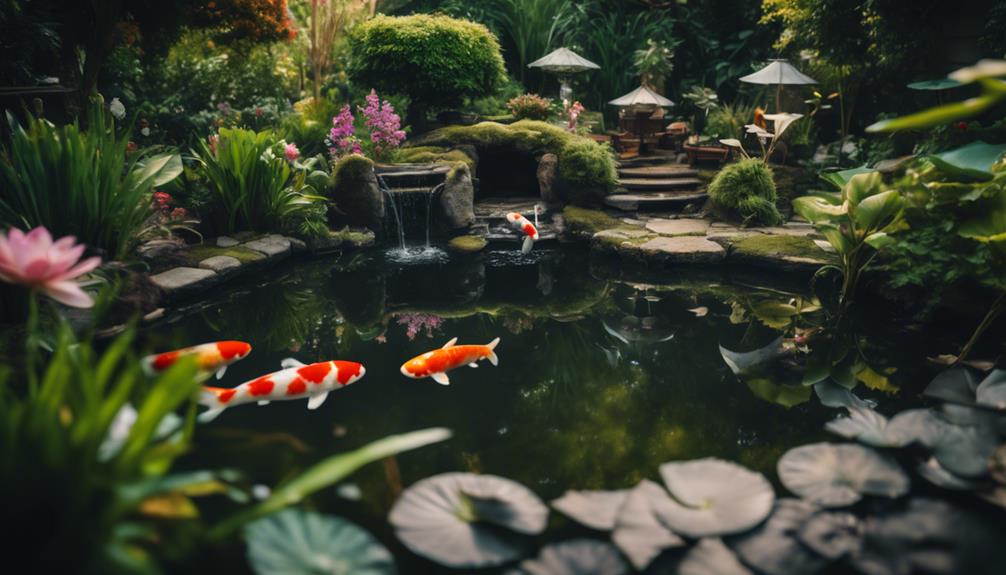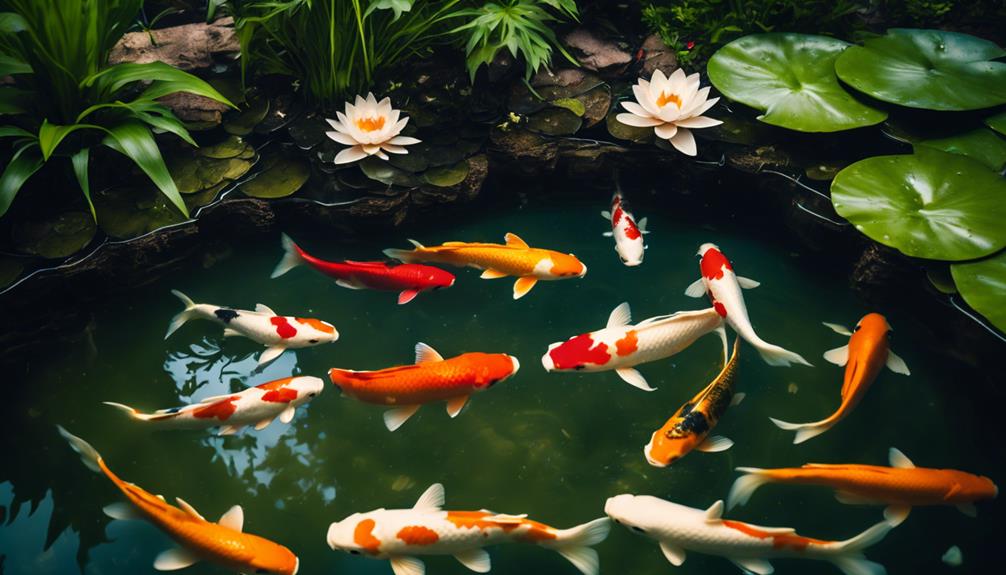You can successfully breed koi in surprisingly small spaces, even as tiny as a few square feet, by creatively overcoming the unique challenges that come with compact environments. For instance, you can use a 3-foot deep area with plants as a nursery for baby koi or employ spawning mops to protect eggs from other fish. By prioritizing pond management, water quality, and space optimization, you can create a thriving koi ecosystem. With the right techniques, such as aquaponics and space-efficient design, you can nurture healthy koi in limited environments. Now, discover how to harness the full potential of your small space koi breeding operation.
Table of Contents
Key Takeaways
- Compact spaces can thrive with koi breeding by using creative solutions like 3-foot deep areas with plants as nurseries for baby koi.
- Spawning mops can be used to protect eggs from other fish, and adult koi can be separated to prevent them from eating eggs and babies.
- Unique breeding environments, such as 1-foot ponds at the top of a waterfall, can be explored to optimize space in small areas.
- Aquaponics systems can promote a healthier environment for koi by integrating plants that purify the water and provide a consistent supply of oxygen and nutrients.
- Proper pond design, water volumes, and space allocation can help overcome challenges in small ponds, allowing koi to thrive in limited environments.
Breeding Koi in Compact Spaces
When breeding koi in compact spaces, you'll need to think creatively to provide a suitable environment for spawning and raising your fish.
A fish tank or a separate tank/pond is ideal for breeding koi, but if you don't have the space, you can get creative.
For instance, you can use a 3-foot deep area with plants as a nursery for the babies. You'll also need to protect the eggs from other fish, which is where spawning mops come in. These can be homemade by tying string together and weighting it down, or bought at pet stores.
Make sure to separate the adult koi from the eggs and babies, as they'll eat them if given the chance.
You'll also need to secure the breeding environment to prevent predators like birds and cats from getting in.
Don't be afraid to think outside the box – or tank – and explore unique breeding environments, such as a 1-foot pond at the top of a waterfall.
With a little creativity, you can successfully breed koi in even the most compact spaces.
Overcoming Challenges in Small Ponds
Breeding koi in small ponds poses unique challenges that you'll need to tackle head-on, from stunted growth and health issues to regular maintenance and predation concerns.
To overcome these challenges, you'll need to prioritize pond management, water quality, and space optimization.
Koi can outgrow small ponds, leading to stunted growth and health problems.
Regular water changes and cleaning are vital to prevent water quality issues.
You'll need to take measures to prevent adult koi from eating eggs and babies, and protect your pond from external predators.
Think outside the box to optimize your space, such as using a 1-foot pond at the top of a waterfall or a large inflatable pool.
Nurturing Koi in Limited Environments

To successfully nurture koi in limited environments, you must carefully plan and execute a strategy that prioritizes ideal water quality, a balanced diet, and sufficient space for exercise and growth.
This means selecting the right food, such as live foods like mosquito larvae and worms, which are essential for koi growth.
A good filtration system is also pivotal to prevent water quality issues and maintain a healthy environment.
When it comes to space efficiency, you can optimize your small space by providing sufficient room for swimming and exercise.
Regular monitoring of your fish's status is paramount to prevent casualties and guarantee they're thriving.
A well-designed filtration system can markedly improve water quality, promoting healthy koi growth even in small spaces.
By prioritizing water quality, fish nutrition, and space efficiency, you can create a thriving environment for your koi.
With proper care and maintenance, koi can flourish in limited environments, making it possible to breed and raise them in small spaces.
Aquaponics for Thriving Koi Ecosystems
By integrating an aquaponics system into your koi breeding setup, you can create a self-sustaining ecosystem that not only benefits the fish but also promotes a healthier environment. This eco-friendly solution allows you to grow plants and raise koi in a closed system, where waste becomes a valuable resource.
Improved water quality: Plants help purify the water, creating a healthier environment for your koi to thrive.
Increased koi growth: With a consistent supply of oxygen and nutrients, your koi will grow strong and healthy.
Reduced waste: The closed system minimizes waste, reducing the need for frequent water changes and minimizing the environmental impact.
Increased crop yield: By utilizing the waste produced by your koi, you can grow a variety of plants, creating a sustainable and thriving ecosystem.
Adapting to Small Pond Constraints

When working with small ponds, you'll face unique challenges that can hinder koi growth and health, including limited space and water quality concerns.
To overcome these obstacles, vital adjustments to your pond design, water volumes, and space allocation are necessary.
Start by optimizing your pond's shape and size to maximize swimming space for your koi. Consider a rectangular or square design, which provides more surface area than a circular pond.
Next, guarantee you have adequate water volumes to support your koi population. A general rule of thumb is to provide at least 10 gallons of water per inch of koi.
Proper space allocation is also pivotal, as koi need room to swim and exercise. Allocate enough space for your koi to move freely, and consider adding plants or decorations to create hiding places and visual interest.
Frequently Asked Questions
Do Koi Fish Like Small Spaces?
You might wonder, do koi fish like small spaces? Notably, koi can thrive in compact areas if you maintain a comfortable water circulation and respect their territoriality, ensuring a suitable comfort level for these majestic creatures.
What Are the Conditions for Koi Breeding?
When breeding koi, you'll need to control water temperature between 65-75°F, guarantee proper tank filtration, and simulate spawning triggers like water changes or increased water flow to encourage successful breeding.
Will Koi Stay Small in a Small Pond?
You'll find that koi won't stay small in a small pond, as overcrowding and growth stunting can occur, leading to water quality issues and health problems; it's vital to prioritize their space and well-being.
How Much Space Do Baby Koi Need?
You'll need to provide about 10-20 gallons of water per baby koi, considering their rapid growth rate, to maintain superior water quality and guarantee a robust filtration system supports their healthy development.
Conclusion
As you venture into koi breeding in compact spaces, remember that necessity is the mother of invention.
By embracing the challenges of small ponds, you can cultivate thriving ecosystems.
With careful planning, clever adaptations, and a dash of creativity, even the most limited environments can flourish.
So, don't be discouraged by size constraints – instead, focus on nurturing your koi and harnessing the power of aquaponics to create a harmonious and productive space.

